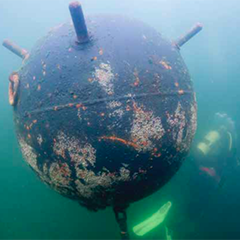Two world wars and years of munitions dumping have left behind a unique and substantial risk legacy on the European seabed. For developers in Europe seeking to build offshore energy infrastructure projects, negotiating the obstacle of thousands of tonnes of unexploded ordnance (UXO) has posed a considerable and often unanticipated challenge. High-profile contractor disputes and costly project delays have been the result.
Simon Cooke, Managing Director of 6 Alpha Associates, a specialist risk company with particular expertise in the assessment and management of offshore UXO, describes the scale of the threat to energy projects in European and global waters and how this explosive risk can be diffused.
Today’s UXO threat in European waters is entirely man-made. It is the result of war fighting and other activities over the last century, including mine laying, naval battles and bombing during the two world wars and dumping of expired munitions by a number of European nations that continued until the 1980s.
The scale of the risk is substantial but difficult to quantify. We know, for example, that up to 30% of the sea mines laid in the period between 1914 and 1945 remain unaccounted for, whilst the nature of post-war dumping operations means that it is hard to gain an accurate figure for the number of tonnes of expired munitions currently sitting on the seabed, although best estimates suggest that this amounts to hundreds of thousands of tonnes.
A cocktail of explosive weaponry is on the ocean floor in the North Sea and English Channel, ranging from sea mines, which have since lost buoyancy, to bombs, shells and torpedoes that missed their intended targets, and, most worryingly perhaps, chemical weapons and mustard gas of the sort disposed of in German waters after WW1. Some of those munitions are buried sub-surface and others move with tides and current – an issue we’ll look at later on.













